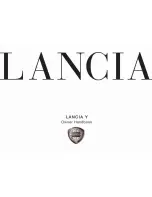
In order for the correctly worn seat belt to provide
the intended level of protection, each vehicle occu-
pant must observe the following information:
R
The seat belt must not be twisted and must fit
tightly and snugly across the body.
R
The seat belt must be routed across the centre
of the shoulder and as low down across the
hips as possible.
R
The shoulder section of the seat belt should
not touch your neck nor be routed under your
arm or behind your back.
R
Avoid wearing bulky clothing, e.g. a winter
coat.
R
Push the lap belt down as far as possible
across your hips and pull tight with the shoul-
der section of the belt. Never route the lap belt
across your abdomen.
Pregnant women must also take particular care
with this.
R
Never route the seat belt across sharp, poin-
ted, abrasive or fragile objects.
R
Only one person should use each seat belt at
any one time.
R
Never secure objects with a seat belt if the
seat belt is being used by one of the vehicle's
occupants.
Also ensure that no objects, e.g. a cushion, are
ever placed between a person and the seat.
If children are travelling in the vehicle, always
observe the instructions and safety notes on "Chil-
dren in the vehicle" (
/
page 39).
Always observe the instructions for loading the
vehicle when securing objects, luggage or loads
(
/
page 206).
Limitations of the protection provided by the seat
belt
&
WARNING Risk of injury or death due to
incorrect seat position
The seat belt will not offer the intended level of
protection if you have not moved the seat
backrest to an almost vertical position.
In particular, you may slip under the seatbelt
and injure yourself.
#
Adjust the seat properly before beginning
your journey.
#
Always ensure that the seat backrest is
in an almost vertical position and that
the shoulder section of your seat belt is
routed across the centre of your shoul-
der.
&
WARNING Risk of injury or death when
additional restraint systems are not used
for persons with a smaller stature
Persons under 1.50 m tall cannot wear the
seat belt correctly without a suitable additional
restraint system.
#
Always secure persons under 1.50 m tall
in a suitable restraint system.
&
WARNING Risk of injury or death due to
damaged or modified seat belts
Seat belts cannot provide protection in the fol-
lowing situations:
R
the seat belt is damaged, has been modi-
fied, is extremely dirty, bleached or dyed
R
the seat belt buckle is damaged or
extremely dirty
R
modifications have been made to the seat
belt tensioner, seat belt anchorage or seat
belt retractor
Seat belts may sustain non-visible damage in
an accident, e.g. due to glass splinters.
Modified or damaged seat belts could tear or
fail in the event of an accident, for example.
Modified seat belt tensioners could acciden-
tally trigger or fail to function as intended.
#
Never modify the seat belt system, for
example the seat belt, seat belt buckle,
seat belt tensioner, seat belt anchorage
and seat belt retractor.
#
Make sure that the seat belts are undam-
aged, not worn and clean.
#
Always have the seat belts checked
immediately after an accident at a quali-
fied specialist workshop.
Mercedes-Benz recommends that you use seat
belts which have been approved for your vehicle by
Mercedes-Benz.
&
WARNING Risk of injury or death from
deployed pyrotechnic seat belt tensioners
Pyrotechnic seat belt tensioners that have
been deployed are no longer operational and
Occupant safety
31
T447 0414 02
Summary of Contents for EQV 2021
Page 1: ...EQV Owner s Manual T447 0414 02 ...
Page 7: ...T447 0414 02 ...
















































